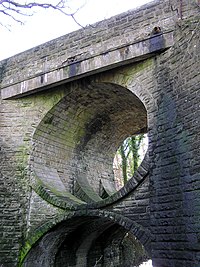Bannockburn: Difference between revisions
m BOT - rv 195.93.21.9 (talk) to last version by Fraslet |
clarification |
||
| Line 5: | Line 5: | ||
'''Bannockburn''' is a village immediately south of the city of [[Stirling]] in [[Scotland]]. It is named after the [[Bannock Burn]], a stream running through the village before flowing into the [[River Forth]]. |
'''Bannockburn''' is a village immediately south of the city of [[Stirling]] in [[Scotland]]. It is named after the [[Bannock Burn]], a stream running through the village before flowing into the [[River Forth]]. |
||
Land in the vicinity of Bannockburn villagge, probably between the Pelstream and Bannock burns (streams)was the site of the [[Battle of Bannockburn]] fought in [[1314]] - one of the pivotal battles of the 13th/14th century [[Scottish Wars of Independence|Wars of Independence]] between [[Scotland]] and [[England]]. A large monument and visitor centre is located near the site of the battle. |
|||
A circular-arch stone [[bridge]], built by engineer [[Thomas Telford]], spans the burn downstream of the battle site. Growth of both Stirling and Bannockburn during the 19th and 20th centuries means that the two now form a contiguous conurbation, and Bannockburn was latterly incorporated into the city (then [[royal burgh]]) of Stirling. The 2001 census population for the area covered by Bannockburn Community Council [http://www.ecommunitycouncil.org.uk/bannockburn/] was 7352. |
A circular-arch stone [[bridge]], built by engineer [[Thomas Telford]], spans the burn downstream of the battle site. Growth of both Stirling and Bannockburn during the 19th and 20th centuries means that the two now form a contiguous conurbation, and Bannockburn was latterly incorporated into the city (then [[royal burgh]]) of Stirling. The 2001 census population for the area covered by Bannockburn Community Council [http://www.ecommunitycouncil.org.uk/bannockburn/] was 7352. |
||
Revision as of 00:19, 1 March 2007
- A number of other places are named after Bannockburn — see Bannockburn (disambiguation).


Bannockburn is a village immediately south of the city of Stirling in Scotland. It is named after the Bannock Burn, a stream running through the village before flowing into the River Forth.
Land in the vicinity of Bannockburn villagge, probably between the Pelstream and Bannock burns (streams)was the site of the Battle of Bannockburn fought in 1314 - one of the pivotal battles of the 13th/14th century Wars of Independence between Scotland and England. A large monument and visitor centre is located near the site of the battle.
A circular-arch stone bridge, built by engineer Thomas Telford, spans the burn downstream of the battle site. Growth of both Stirling and Bannockburn during the 19th and 20th centuries means that the two now form a contiguous conurbation, and Bannockburn was latterly incorporated into the city (then royal burgh) of Stirling. The 2001 census population for the area covered by Bannockburn Community Council [1] was 7352.
The area contains most necessary amenities, including a library, bank and local shops. It is served by Bannockburn Primary School, in the centre of the community, and Bannockburn High School in nearby Broomridge. Several new private housing schemes have been built in and around Bannockburn since the 1990s, increasing pressure on the already-overcrowded high school but also bringing a more middle-class population to the area.
External links
- Map sources for Bannockburn
- Stirling
